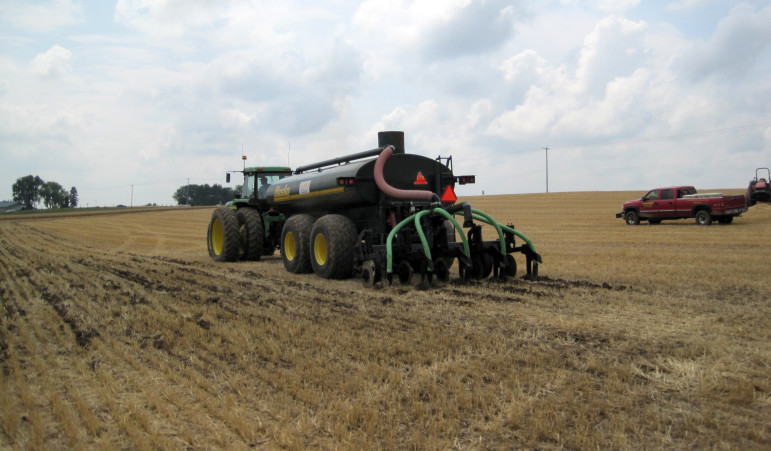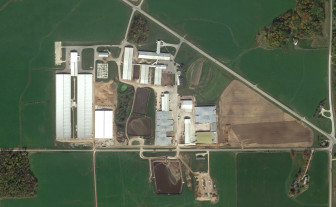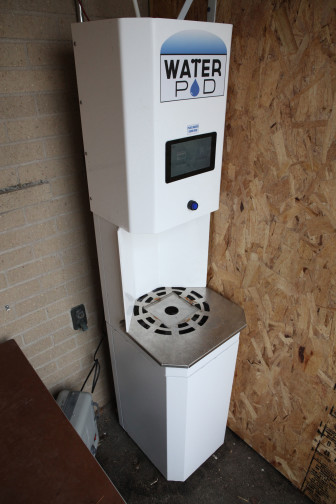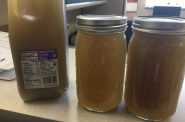Bacteria Taints State’s Drinking Water
169,00 households served by private wells that tested positive for coliform bacteria.
Proposals aim to improve water
Legislation aimed at bolstering protections against manure pollution in areas with fractured bedrock, such as Kewaunee County, was introduced by Democratic lawmakers in January.
“We are dealing with a public health crisis,” said state Rep. Eric Genrich, D-Green Bay, who co-authored the bill with state Sen. Dave Hansen, D-Green Bay. “We have communities in northeast Wisconsin where half of the wells that are tested are contaminated and the water is undrinkable, where residents no longer have access to safe, clean drinking water. That is not acceptable.”
The bill did not advance in the Republican-controlled Legislature. State Rep. Joel Kitchens, R-Sturgeon Bay, called it a “political stunt.” He said it was not a serious effort because Hansen and Genrich did not consult him or other Republicans.
In the meantime, Kitchens has introduced a bill of his own that would raise the maximum household income from $60,000 to $90,000 under the Well Compensation Grant Program, which helps owners pay for replacement of wells contaminated by livestock feces. But he acknowledged the change is not a solution to the pollution problems.
Three counties — Brown, Manitowoc and Kewaunee — have acted on their own, passing ordinances that prohibit winter manure spreading or restrict spreading on land with porous bedrock. One of the Kewaunee County work groups formed after residents petitioned the EPA for help has proposed a number of restrictions on spreading manure, including a ban on spreading where bedrock is covered by less than 24 inches of soil.

Manure is spread during a demonstration at Crave Brothers Farm in Dodge County during Farm Technology Days on July 22, 2009. Manure from large dairy operations has caused drinking water contamination in Brown and Kewaunee counties in recent years. Photo by Carolyn Betz of the University of Wisconsin Sea Grant Institute.
Kewaunee County’s ordinance passed in the face of strong opposition from the Dairy Business Association, the Midwest Food Producers Association and other agriculture groups. They contend the county does not have the authority to pass such limits, which they say are unnecessary because the state DNR already regulates groundwater.
But a study of the new county regulations, published in 2015 in the journal Resources, concluded the rules have caused “statistically significant reductions” in well contamination compared to other counties with fractured bedrock that only offered voluntary education on best practices to farmers and manure spreaders. The study showed no improvement in those counties.
Tim Trotter, executive director of the DBA, the state’s most powerful dairy lobby, said dairy farmers are serious about ensuring clean and safe water. But owners of some large-scale farms insist more research is needed. They say any new state regulations also must take into account the impact on agriculture.

A view of Pagel’s Ponderosa Dairy in Kewaunee County. Owner John Pagel is a member of the Kewaunee County Board and head of the county’s Land and Conservation Committee. Pagel has acknowledged that large dairy operations such as his can contribute to groundwater pollution but said industry can lead the way toward a solution. Image from Google Earth.
“I think with any new rules there should be a balance between safety and being practical,” said John Pagel, who owns a large dairy farm and serves on the Kewaunee County Board, chairing the Land and Water Conservation Committee. “We need to keep working together to make sure farming practices are done the right way and at the same time set goals that are achievable.”
Lee Luft, a Kewaunee County Board member who is part of the DNR work groups, said residents will be watching the agency’s actions closely.
“If these recommendations are not implemented,” he said, “my sense is that whatever remaining confidence the residents have in the DNR will evaporate.”
Dangerously high contamination
Many users of private wells may be ingesting pathogens unknowingly because, according to the state health department, only about 16 percent of owners statewide have them tested.
The Tremls tested their private water well after Samantha and other members of the family got sick. The astronomically high levels of contamination caused the county to advise the family to shut off the water and get the children out of the house.
The E. coli count in the Treml well was 2,800 parts per milliliter and the coliform count was 9,800. The EPA considers any amount of E. coli to be dangerous.
The Tremls later discovered the DNR had allowed a neighboring farmer to spread liquid manure on frozen land next to their home after the farmer ran out of storage space. Manure spread on frozen ground can run off into surface water and get into the drinking water supply.
Judy Treml had hoped their ordeal would spur the DNR to action. That did not happen.
“It does make me angry,” Treml said. “I thought they would use our case to learn how to avoid these issues altogether.”
Groups charge DNR regulation lax
The DNR’s seeming reluctance to address concerns about pollution from the big farms is not new, according to an April 2015 investigation by a group called the Socially Responsible Agricultural Project, based in the state of Oregon. The group’s “Rap Sheets” report documented a lack of DNR enforcement on large-scale farms in Kewaunee County going back to the mid-1980s.
Using the DNR’s own records, the group uncovered dozens of instances in which large dairy farms violated anti-pollution laws. It found cases including overapplication of manure, failure to report spills, failure to maintain adequate storage, and spreading manure too close to homes and waterways — incidents in which DNR records do not show follow-up to ensure problems were corrected.

A clean water kiosk is seen in a shed located outside of the Algoma High School. The water access point was donated by Stonehouse Water Technologies of Milwaukee, and provides clean drinking water to registered Kewaunee County residents. Algoma’s school superintendent Nick Cochart says the kiosk has been vandalized three times since its installation in January 2016. Photo by Coburn Dukehart of the Wisconsin Center for Investigative Journalism.
The agency disputed the report — saying it was enforcing the law to its fullest authority — but allegations of lax regulation continued to surface.
In October, Midwest Environmental Advocates filed another petition, this time on behalf of 16 residents from across Wisconsin, asking the EPA to rescind the state’s authority to enforce discharge permits under the Clean Water Act if changes are not forthcoming.
And in December, 45 former DNR employees, many with decades of experience, supported that petition in a letter to the EPA. Among the concerns they cited was lax enforcement against polluters, including CAFOs.
Cochart, Algoma’s school superintendent, said he is fed up with delays by DNR in getting help to county residents. “All they do is drag their feet,” he said.
“Somebody needs to provide clean water. The DNR certainly isn’t,” Cochart added. “To me, it’s a basic human right to have clean drinking water. But there are a lot of people here who are spending a lot of money to have clean water.”
Luft, the Kewaunee County Board member, said the high levels of lead in drinking water that plagued Flint, Michigan, are reminiscent of problems in his county.
“It brought home the fact to me that we have a very substantial number of people living without access to safe water,” Luft said. “They live a second-class lifestyle because of it.”
The nonprofit Wisconsin Center for Investigative Journalism (www.WisconsinWatch.org) collaborates with Wisconsin Public Radio, Wisconsin Public Television, other news media and the UW-Madison School of Journalism and Mass Communication. All works created, published, posted or disseminated by the Center do not necessarily reflect the views or opinions of UW-Madison or any of its affiliates.
Tainted Water
-
Fecal Microbes In 60% of Sampled Wells
 Jun 12th, 2017 by Coburn Dukehart
Jun 12th, 2017 by Coburn Dukehart
-
State’s Failures On Lead Pipes
 Jan 15th, 2017 by Cara Lombardo and Dee J. Hall
Jan 15th, 2017 by Cara Lombardo and Dee J. Hall
-
Lax Rules Expose Kids To Lead-Tainted Water
 Dec 19th, 2016 by Cara Lombardo and Dee J. Hall
Dec 19th, 2016 by Cara Lombardo and Dee J. Hall

















My only problem with this article is the headline… As the DNR graph points out, most bacteria isn’t problematic. And you better believe city water – ALL water, for that matter – is “tainted” with bacteria of some form. A more appropriate title may have included the word ‘dangerous’ or a synonym.
Otherwise, sucks for the well drinkers – a majority of wisconsinites. Hopefully some of the outlined solutions can help with thr coliform problem.
Thank god we have a state DNR with scientists that can regulate the huge agribusinesses where….Oh, wait, what’s that? Oops.
Wisconsin is fast becoming an unsafe place to live. We have bad water wells in Kewaunee County and also wells in Racine County polluted by the use of coal ash for back fill around buildings and roadways. The DNR does not seem to have the personal or the interest to identify and fix the problems. In the South West quarter of Wisconsin we are mining the silica sand that is used in the frack mining industry. The levels of dust in the air are not controlled well and the silica material is a health hazard. Lakes and rivers and water wells are drying up because of high capacity wells that are used in the farming and mining industry.
Yes there have always been problems but these things are new and accelerating in number.